Unilever HRM: Guest Model, Flexibility, and Discrimination Report
VerifiedAdded on 2020/07/22
|16
|5329
|177
Report
AI Summary
This report provides a comprehensive overview of human resource management (HRM) principles and practices, using Unilever as a case study. It begins by examining the Guest model of HRM, exploring its various components and implications for organizational success. The report then delves into the concept of flexibility in the workplace, analyzing different models and types of flexibility, including functional, numerical, and financial flexibility, as well as flexible working hours. The discussion extends to the impact of changes in the labor market on flexible working arrangements. The report also addresses the critical issue of discrimination in the workplace, outlining different forms of discrimination and the practical implications of equal opportunities legislation for organizations. Furthermore, it compares approaches to managing equal opportunities and diversity. Finally, the report explores performance management techniques and the practice of managing employee welfare, including the implications of health and safety legislation and topical issues affecting human resources practices.
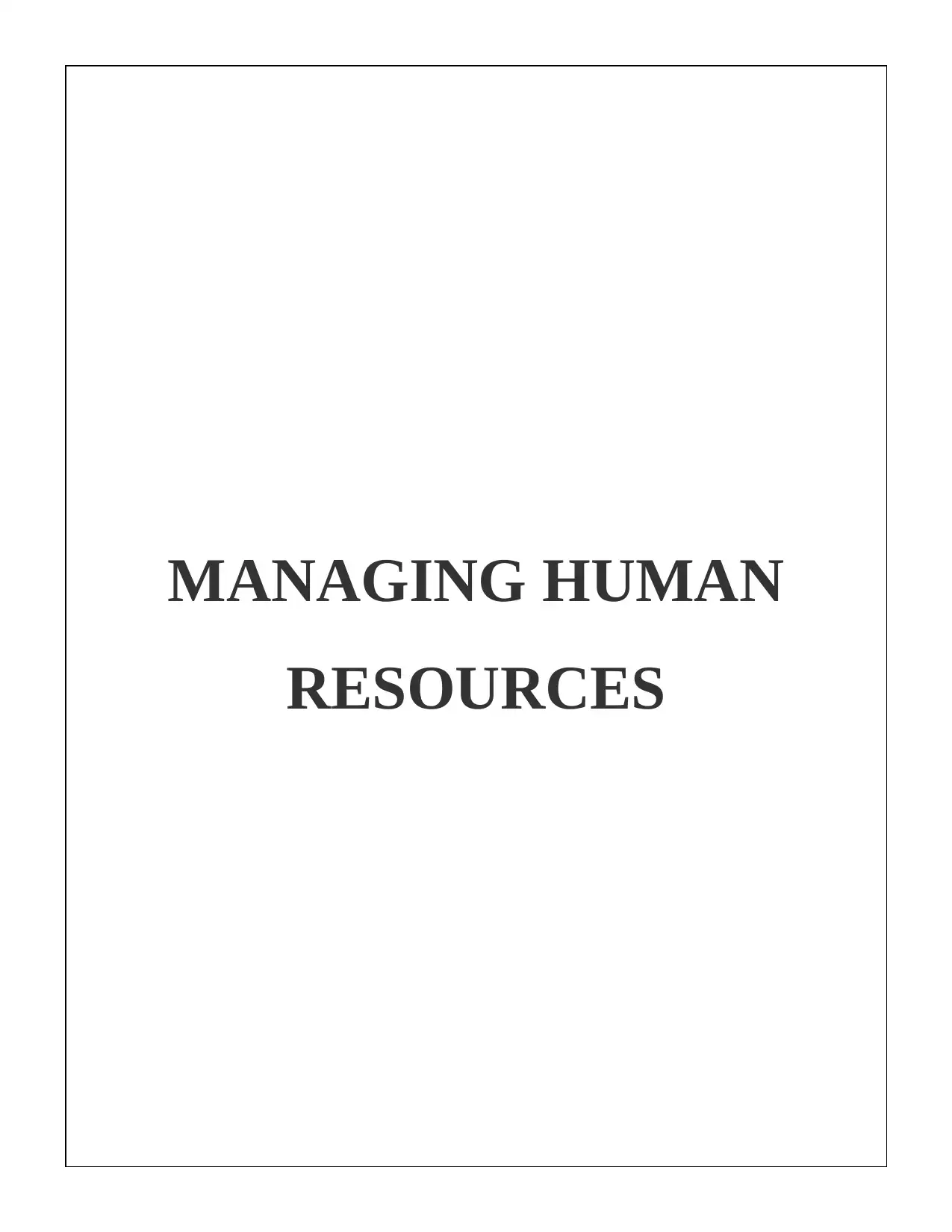
MANAGING HUMAN
RESOURCES
RESOURCES
Paraphrase This Document
Need a fresh take? Get an instant paraphrase of this document with our AI Paraphraser
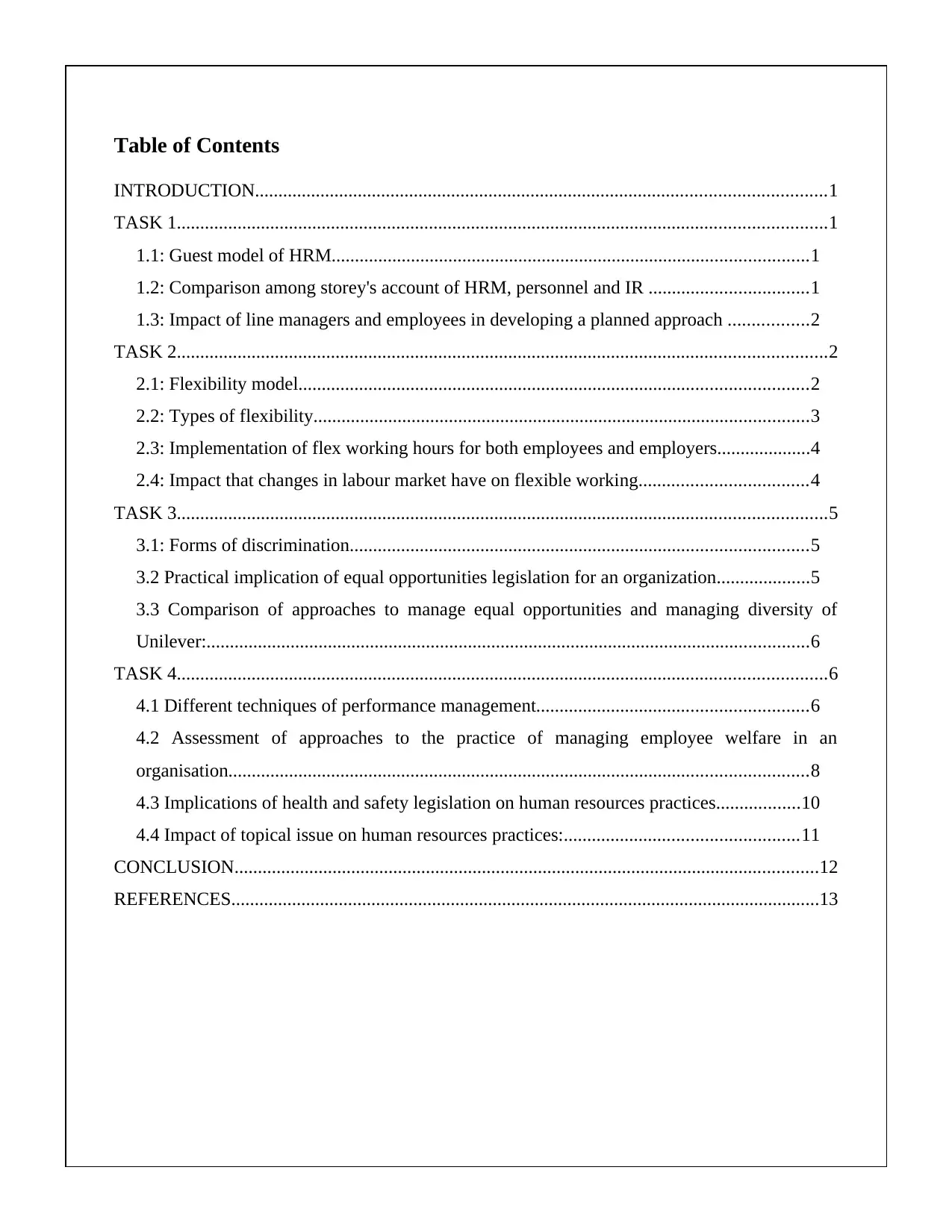
Table of Contents
INTRODUCTION..........................................................................................................................1
TASK 1...........................................................................................................................................1
1.1: Guest model of HRM......................................................................................................1
1.2: Comparison among storey's account of HRM, personnel and IR ..................................1
1.3: Impact of line managers and employees in developing a planned approach .................2
TASK 2...........................................................................................................................................2
2.1: Flexibility model.............................................................................................................2
2.2: Types of flexibility..........................................................................................................3
2.3: Implementation of flex working hours for both employees and employers....................4
2.4: Impact that changes in labour market have on flexible working....................................4
TASK 3...........................................................................................................................................5
3.1: Forms of discrimination..................................................................................................5
3.2 Practical implication of equal opportunities legislation for an organization....................5
3.3 Comparison of approaches to manage equal opportunities and managing diversity of
Unilever:.................................................................................................................................6
TASK 4...........................................................................................................................................6
4.1 Different techniques of performance management..........................................................6
4.2 Assessment of approaches to the practice of managing employee welfare in an
organisation............................................................................................................................8
4.3 Implications of health and safety legislation on human resources practices..................10
4.4 Impact of topical issue on human resources practices:..................................................11
CONCLUSION.............................................................................................................................12
REFERENCES..............................................................................................................................13
INTRODUCTION..........................................................................................................................1
TASK 1...........................................................................................................................................1
1.1: Guest model of HRM......................................................................................................1
1.2: Comparison among storey's account of HRM, personnel and IR ..................................1
1.3: Impact of line managers and employees in developing a planned approach .................2
TASK 2...........................................................................................................................................2
2.1: Flexibility model.............................................................................................................2
2.2: Types of flexibility..........................................................................................................3
2.3: Implementation of flex working hours for both employees and employers....................4
2.4: Impact that changes in labour market have on flexible working....................................4
TASK 3...........................................................................................................................................5
3.1: Forms of discrimination..................................................................................................5
3.2 Practical implication of equal opportunities legislation for an organization....................5
3.3 Comparison of approaches to manage equal opportunities and managing diversity of
Unilever:.................................................................................................................................6
TASK 4...........................................................................................................................................6
4.1 Different techniques of performance management..........................................................6
4.2 Assessment of approaches to the practice of managing employee welfare in an
organisation............................................................................................................................8
4.3 Implications of health and safety legislation on human resources practices..................10
4.4 Impact of topical issue on human resources practices:..................................................11
CONCLUSION.............................................................................................................................12
REFERENCES..............................................................................................................................13
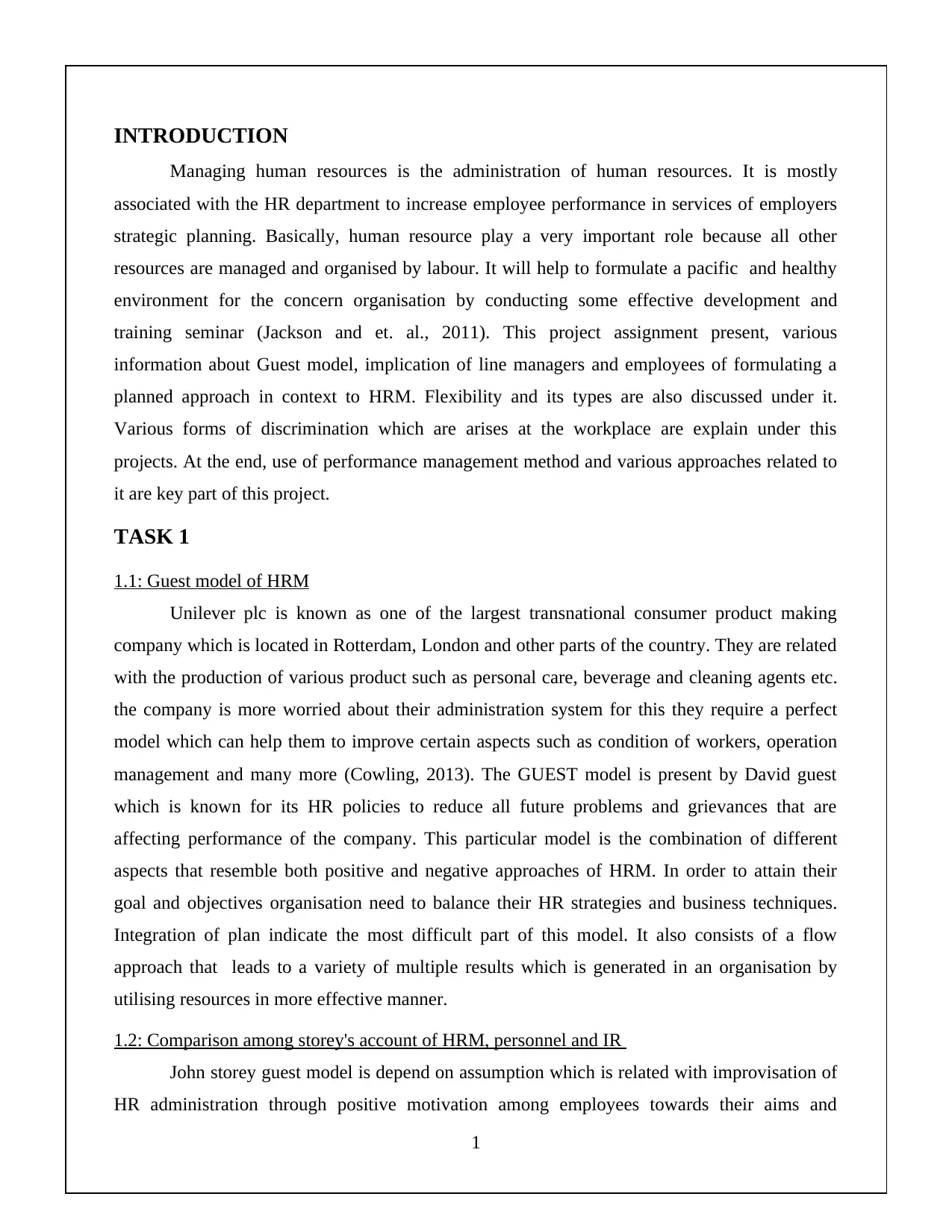
INTRODUCTION
Managing human resources is the administration of human resources. It is mostly
associated with the HR department to increase employee performance in services of employers
strategic planning. Basically, human resource play a very important role because all other
resources are managed and organised by labour. It will help to formulate a pacific and healthy
environment for the concern organisation by conducting some effective development and
training seminar (Jackson and et. al., 2011). This project assignment present, various
information about Guest model, implication of line managers and employees of formulating a
planned approach in context to HRM. Flexibility and its types are also discussed under it.
Various forms of discrimination which are arises at the workplace are explain under this
projects. At the end, use of performance management method and various approaches related to
it are key part of this project.
TASK 1
1.1: Guest model of HRM
Unilever plc is known as one of the largest transnational consumer product making
company which is located in Rotterdam, London and other parts of the country. They are related
with the production of various product such as personal care, beverage and cleaning agents etc.
the company is more worried about their administration system for this they require a perfect
model which can help them to improve certain aspects such as condition of workers, operation
management and many more (Cowling, 2013). The GUEST model is present by David guest
which is known for its HR policies to reduce all future problems and grievances that are
affecting performance of the company. This particular model is the combination of different
aspects that resemble both positive and negative approaches of HRM. In order to attain their
goal and objectives organisation need to balance their HR strategies and business techniques.
Integration of plan indicate the most difficult part of this model. It also consists of a flow
approach that leads to a variety of multiple results which is generated in an organisation by
utilising resources in more effective manner.
1.2: Comparison among storey's account of HRM, personnel and IR
John storey guest model is depend on assumption which is related with improvisation of
HR administration through positive motivation among employees towards their aims and
1
Managing human resources is the administration of human resources. It is mostly
associated with the HR department to increase employee performance in services of employers
strategic planning. Basically, human resource play a very important role because all other
resources are managed and organised by labour. It will help to formulate a pacific and healthy
environment for the concern organisation by conducting some effective development and
training seminar (Jackson and et. al., 2011). This project assignment present, various
information about Guest model, implication of line managers and employees of formulating a
planned approach in context to HRM. Flexibility and its types are also discussed under it.
Various forms of discrimination which are arises at the workplace are explain under this
projects. At the end, use of performance management method and various approaches related to
it are key part of this project.
TASK 1
1.1: Guest model of HRM
Unilever plc is known as one of the largest transnational consumer product making
company which is located in Rotterdam, London and other parts of the country. They are related
with the production of various product such as personal care, beverage and cleaning agents etc.
the company is more worried about their administration system for this they require a perfect
model which can help them to improve certain aspects such as condition of workers, operation
management and many more (Cowling, 2013). The GUEST model is present by David guest
which is known for its HR policies to reduce all future problems and grievances that are
affecting performance of the company. This particular model is the combination of different
aspects that resemble both positive and negative approaches of HRM. In order to attain their
goal and objectives organisation need to balance their HR strategies and business techniques.
Integration of plan indicate the most difficult part of this model. It also consists of a flow
approach that leads to a variety of multiple results which is generated in an organisation by
utilising resources in more effective manner.
1.2: Comparison among storey's account of HRM, personnel and IR
John storey guest model is depend on assumption which is related with improvisation of
HR administration through positive motivation among employees towards their aims and
1
⊘ This is a preview!⊘
Do you want full access?
Subscribe today to unlock all pages.

Trusted by 1+ million students worldwide
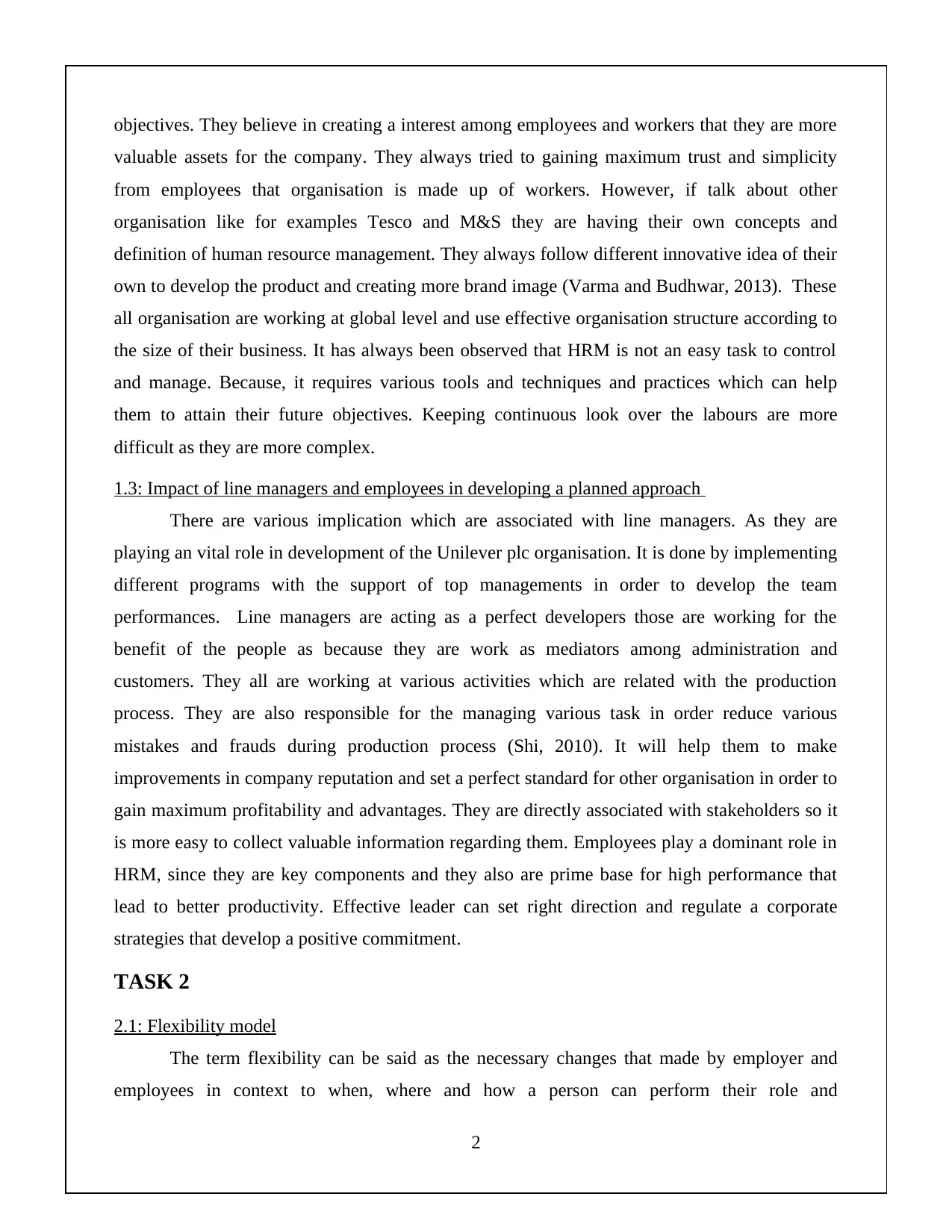
objectives. They believe in creating a interest among employees and workers that they are more
valuable assets for the company. They always tried to gaining maximum trust and simplicity
from employees that organisation is made up of workers. However, if talk about other
organisation like for examples Tesco and M&S they are having their own concepts and
definition of human resource management. They always follow different innovative idea of their
own to develop the product and creating more brand image (Varma and Budhwar, 2013). These
all organisation are working at global level and use effective organisation structure according to
the size of their business. It has always been observed that HRM is not an easy task to control
and manage. Because, it requires various tools and techniques and practices which can help
them to attain their future objectives. Keeping continuous look over the labours are more
difficult as they are more complex.
1.3: Impact of line managers and employees in developing a planned approach
There are various implication which are associated with line managers. As they are
playing an vital role in development of the Unilever plc organisation. It is done by implementing
different programs with the support of top managements in order to develop the team
performances. Line managers are acting as a perfect developers those are working for the
benefit of the people as because they are work as mediators among administration and
customers. They all are working at various activities which are related with the production
process. They are also responsible for the managing various task in order reduce various
mistakes and frauds during production process (Shi, 2010). It will help them to make
improvements in company reputation and set a perfect standard for other organisation in order to
gain maximum profitability and advantages. They are directly associated with stakeholders so it
is more easy to collect valuable information regarding them. Employees play a dominant role in
HRM, since they are key components and they also are prime base for high performance that
lead to better productivity. Effective leader can set right direction and regulate a corporate
strategies that develop a positive commitment.
TASK 2
2.1: Flexibility model
The term flexibility can be said as the necessary changes that made by employer and
employees in context to when, where and how a person can perform their role and
2
valuable assets for the company. They always tried to gaining maximum trust and simplicity
from employees that organisation is made up of workers. However, if talk about other
organisation like for examples Tesco and M&S they are having their own concepts and
definition of human resource management. They always follow different innovative idea of their
own to develop the product and creating more brand image (Varma and Budhwar, 2013). These
all organisation are working at global level and use effective organisation structure according to
the size of their business. It has always been observed that HRM is not an easy task to control
and manage. Because, it requires various tools and techniques and practices which can help
them to attain their future objectives. Keeping continuous look over the labours are more
difficult as they are more complex.
1.3: Impact of line managers and employees in developing a planned approach
There are various implication which are associated with line managers. As they are
playing an vital role in development of the Unilever plc organisation. It is done by implementing
different programs with the support of top managements in order to develop the team
performances. Line managers are acting as a perfect developers those are working for the
benefit of the people as because they are work as mediators among administration and
customers. They all are working at various activities which are related with the production
process. They are also responsible for the managing various task in order reduce various
mistakes and frauds during production process (Shi, 2010). It will help them to make
improvements in company reputation and set a perfect standard for other organisation in order to
gain maximum profitability and advantages. They are directly associated with stakeholders so it
is more easy to collect valuable information regarding them. Employees play a dominant role in
HRM, since they are key components and they also are prime base for high performance that
lead to better productivity. Effective leader can set right direction and regulate a corporate
strategies that develop a positive commitment.
TASK 2
2.1: Flexibility model
The term flexibility can be said as the necessary changes that made by employer and
employees in context to when, where and how a person can perform their role and
2
Paraphrase This Document
Need a fresh take? Get an instant paraphrase of this document with our AI Paraphraser
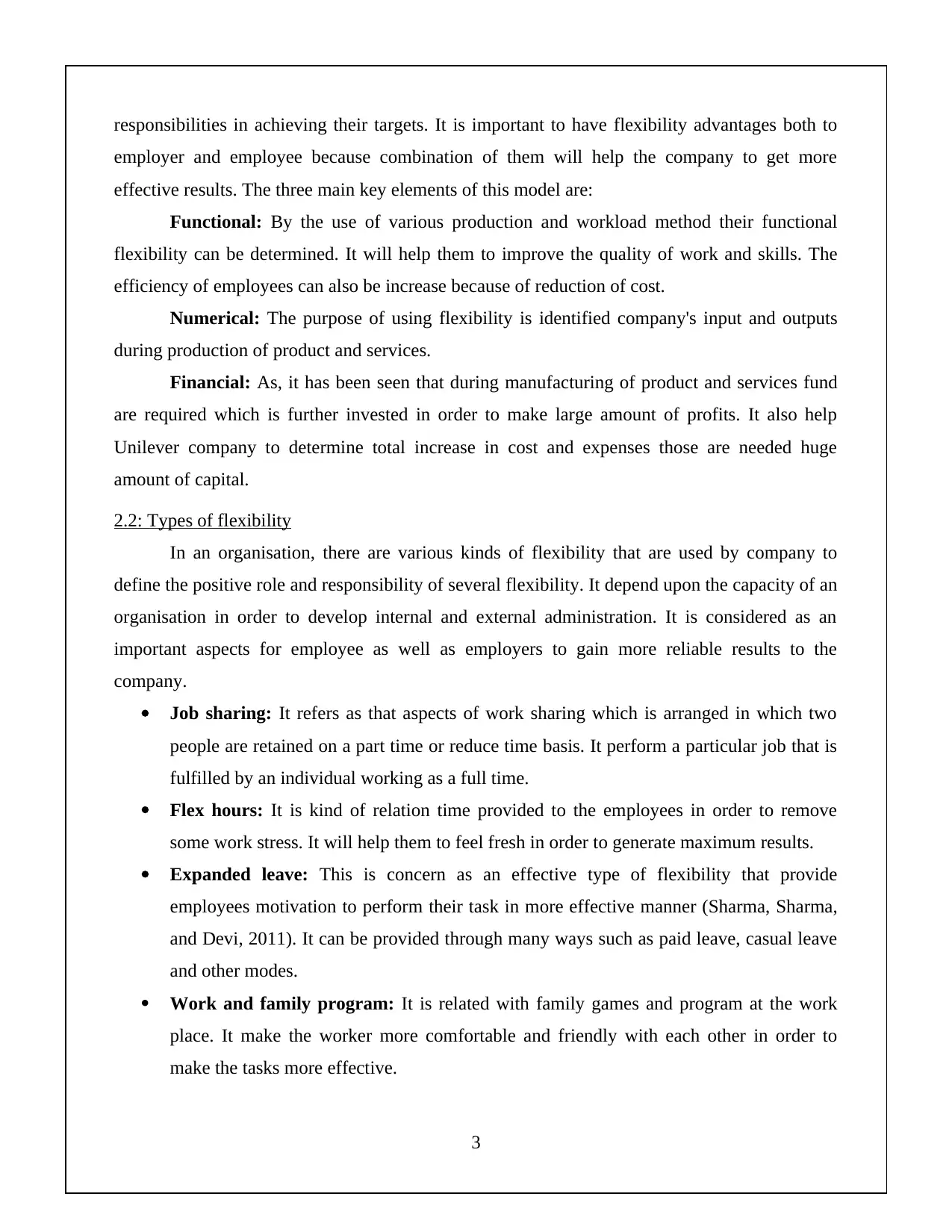
responsibilities in achieving their targets. It is important to have flexibility advantages both to
employer and employee because combination of them will help the company to get more
effective results. The three main key elements of this model are:
Functional: By the use of various production and workload method their functional
flexibility can be determined. It will help them to improve the quality of work and skills. The
efficiency of employees can also be increase because of reduction of cost.
Numerical: The purpose of using flexibility is identified company's input and outputs
during production of product and services.
Financial: As, it has been seen that during manufacturing of product and services fund
are required which is further invested in order to make large amount of profits. It also help
Unilever company to determine total increase in cost and expenses those are needed huge
amount of capital.
2.2: Types of flexibility
In an organisation, there are various kinds of flexibility that are used by company to
define the positive role and responsibility of several flexibility. It depend upon the capacity of an
organisation in order to develop internal and external administration. It is considered as an
important aspects for employee as well as employers to gain more reliable results to the
company.
Job sharing: It refers as that aspects of work sharing which is arranged in which two
people are retained on a part time or reduce time basis. It perform a particular job that is
fulfilled by an individual working as a full time.
Flex hours: It is kind of relation time provided to the employees in order to remove
some work stress. It will help them to feel fresh in order to generate maximum results.
Expanded leave: This is concern as an effective type of flexibility that provide
employees motivation to perform their task in more effective manner (Sharma, Sharma,
and Devi, 2011). It can be provided through many ways such as paid leave, casual leave
and other modes.
Work and family program: It is related with family games and program at the work
place. It make the worker more comfortable and friendly with each other in order to
make the tasks more effective.
3
employer and employee because combination of them will help the company to get more
effective results. The three main key elements of this model are:
Functional: By the use of various production and workload method their functional
flexibility can be determined. It will help them to improve the quality of work and skills. The
efficiency of employees can also be increase because of reduction of cost.
Numerical: The purpose of using flexibility is identified company's input and outputs
during production of product and services.
Financial: As, it has been seen that during manufacturing of product and services fund
are required which is further invested in order to make large amount of profits. It also help
Unilever company to determine total increase in cost and expenses those are needed huge
amount of capital.
2.2: Types of flexibility
In an organisation, there are various kinds of flexibility that are used by company to
define the positive role and responsibility of several flexibility. It depend upon the capacity of an
organisation in order to develop internal and external administration. It is considered as an
important aspects for employee as well as employers to gain more reliable results to the
company.
Job sharing: It refers as that aspects of work sharing which is arranged in which two
people are retained on a part time or reduce time basis. It perform a particular job that is
fulfilled by an individual working as a full time.
Flex hours: It is kind of relation time provided to the employees in order to remove
some work stress. It will help them to feel fresh in order to generate maximum results.
Expanded leave: This is concern as an effective type of flexibility that provide
employees motivation to perform their task in more effective manner (Sharma, Sharma,
and Devi, 2011). It can be provided through many ways such as paid leave, casual leave
and other modes.
Work and family program: It is related with family games and program at the work
place. It make the worker more comfortable and friendly with each other in order to
make the tasks more effective.
3
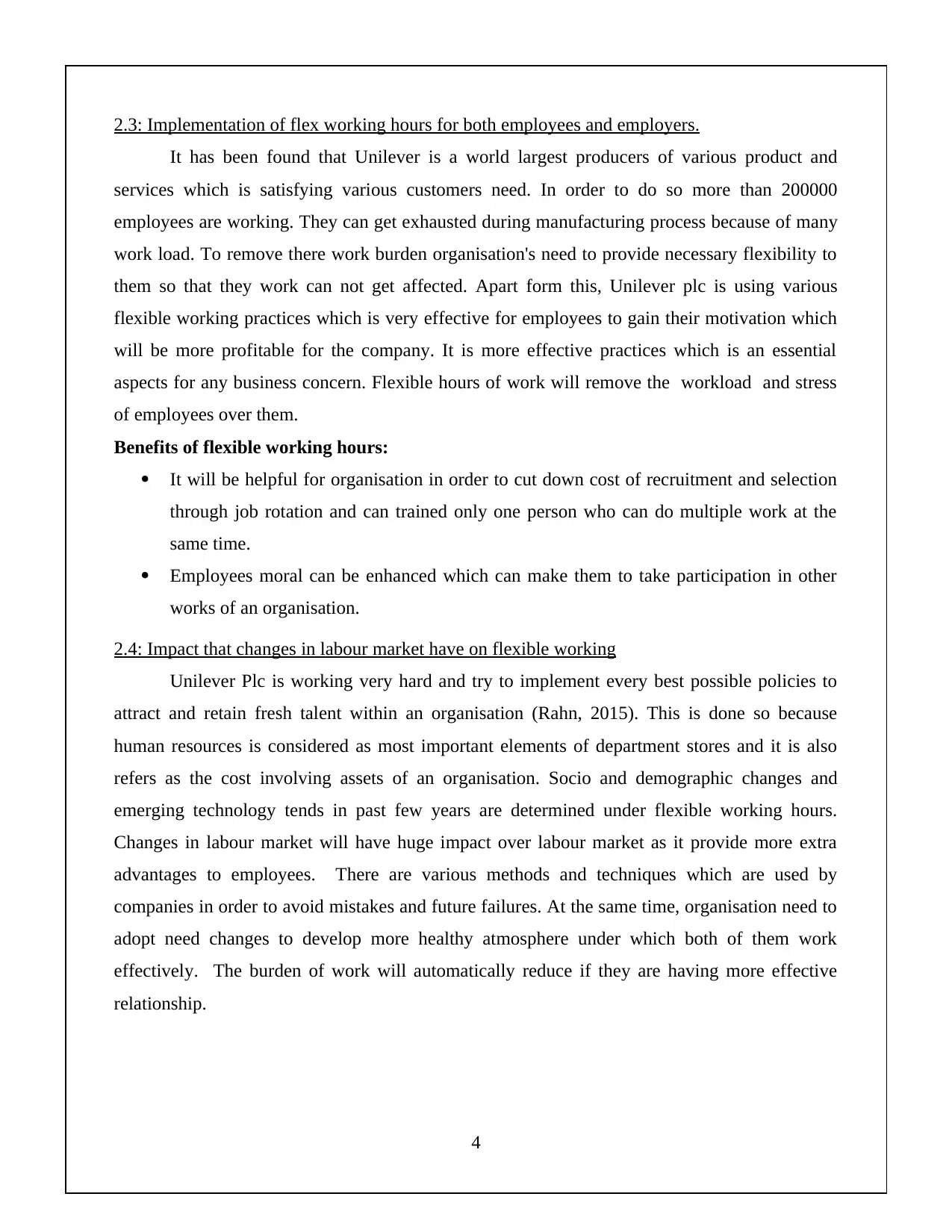
2.3: Implementation of flex working hours for both employees and employers.
It has been found that Unilever is a world largest producers of various product and
services which is satisfying various customers need. In order to do so more than 200000
employees are working. They can get exhausted during manufacturing process because of many
work load. To remove there work burden organisation's need to provide necessary flexibility to
them so that they work can not get affected. Apart form this, Unilever plc is using various
flexible working practices which is very effective for employees to gain their motivation which
will be more profitable for the company. It is more effective practices which is an essential
aspects for any business concern. Flexible hours of work will remove the workload and stress
of employees over them.
Benefits of flexible working hours:
It will be helpful for organisation in order to cut down cost of recruitment and selection
through job rotation and can trained only one person who can do multiple work at the
same time.
Employees moral can be enhanced which can make them to take participation in other
works of an organisation.
2.4: Impact that changes in labour market have on flexible working
Unilever Plc is working very hard and try to implement every best possible policies to
attract and retain fresh talent within an organisation (Rahn, 2015). This is done so because
human resources is considered as most important elements of department stores and it is also
refers as the cost involving assets of an organisation. Socio and demographic changes and
emerging technology tends in past few years are determined under flexible working hours.
Changes in labour market will have huge impact over labour market as it provide more extra
advantages to employees. There are various methods and techniques which are used by
companies in order to avoid mistakes and future failures. At the same time, organisation need to
adopt need changes to develop more healthy atmosphere under which both of them work
effectively. The burden of work will automatically reduce if they are having more effective
relationship.
4
It has been found that Unilever is a world largest producers of various product and
services which is satisfying various customers need. In order to do so more than 200000
employees are working. They can get exhausted during manufacturing process because of many
work load. To remove there work burden organisation's need to provide necessary flexibility to
them so that they work can not get affected. Apart form this, Unilever plc is using various
flexible working practices which is very effective for employees to gain their motivation which
will be more profitable for the company. It is more effective practices which is an essential
aspects for any business concern. Flexible hours of work will remove the workload and stress
of employees over them.
Benefits of flexible working hours:
It will be helpful for organisation in order to cut down cost of recruitment and selection
through job rotation and can trained only one person who can do multiple work at the
same time.
Employees moral can be enhanced which can make them to take participation in other
works of an organisation.
2.4: Impact that changes in labour market have on flexible working
Unilever Plc is working very hard and try to implement every best possible policies to
attract and retain fresh talent within an organisation (Rahn, 2015). This is done so because
human resources is considered as most important elements of department stores and it is also
refers as the cost involving assets of an organisation. Socio and demographic changes and
emerging technology tends in past few years are determined under flexible working hours.
Changes in labour market will have huge impact over labour market as it provide more extra
advantages to employees. There are various methods and techniques which are used by
companies in order to avoid mistakes and future failures. At the same time, organisation need to
adopt need changes to develop more healthy atmosphere under which both of them work
effectively. The burden of work will automatically reduce if they are having more effective
relationship.
4
⊘ This is a preview!⊘
Do you want full access?
Subscribe today to unlock all pages.

Trusted by 1+ million students worldwide
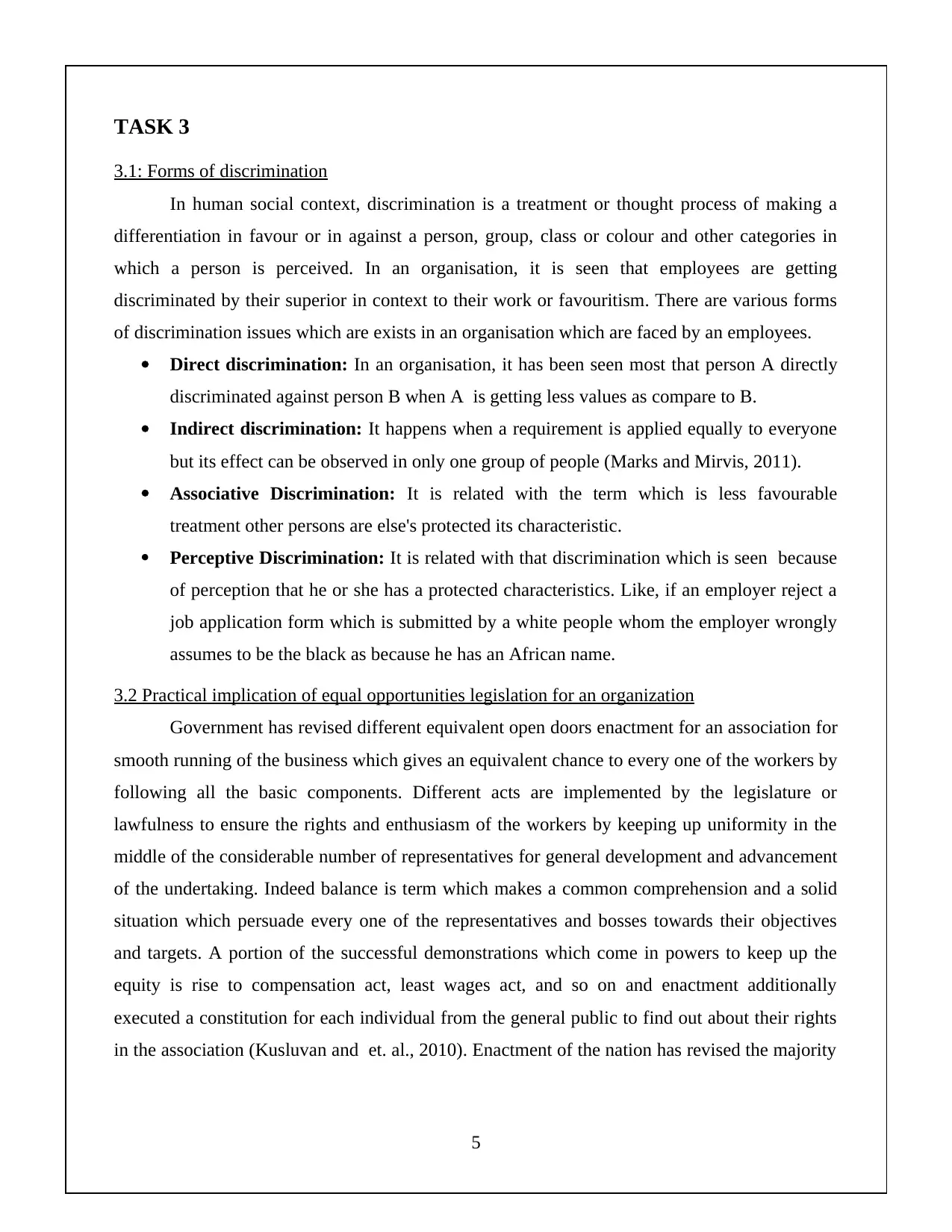
TASK 3
3.1: Forms of discrimination
In human social context, discrimination is a treatment or thought process of making a
differentiation in favour or in against a person, group, class or colour and other categories in
which a person is perceived. In an organisation, it is seen that employees are getting
discriminated by their superior in context to their work or favouritism. There are various forms
of discrimination issues which are exists in an organisation which are faced by an employees.
Direct discrimination: In an organisation, it has been seen most that person A directly
discriminated against person B when A is getting less values as compare to B.
Indirect discrimination: It happens when a requirement is applied equally to everyone
but its effect can be observed in only one group of people (Marks and Mirvis, 2011).
Associative Discrimination: It is related with the term which is less favourable
treatment other persons are else's protected its characteristic.
Perceptive Discrimination: It is related with that discrimination which is seen because
of perception that he or she has a protected characteristics. Like, if an employer reject a
job application form which is submitted by a white people whom the employer wrongly
assumes to be the black as because he has an African name.
3.2 Practical implication of equal opportunities legislation for an organization
Government has revised different equivalent open doors enactment for an association for
smooth running of the business which gives an equivalent chance to every one of the workers by
following all the basic components. Different acts are implemented by the legislature or
lawfulness to ensure the rights and enthusiasm of the workers by keeping up uniformity in the
middle of the considerable number of representatives for general development and advancement
of the undertaking. Indeed balance is term which makes a common comprehension and a solid
situation which persuade every one of the representatives and bosses towards their objectives
and targets. A portion of the successful demonstrations which come in powers to keep up the
equity is rise to compensation act, least wages act, and so on and enactment additionally
executed a constitution for each individual from the general public to find out about their rights
in the association (Kusluvan and et. al., 2010). Enactment of the nation has revised the majority
5
3.1: Forms of discrimination
In human social context, discrimination is a treatment or thought process of making a
differentiation in favour or in against a person, group, class or colour and other categories in
which a person is perceived. In an organisation, it is seen that employees are getting
discriminated by their superior in context to their work or favouritism. There are various forms
of discrimination issues which are exists in an organisation which are faced by an employees.
Direct discrimination: In an organisation, it has been seen most that person A directly
discriminated against person B when A is getting less values as compare to B.
Indirect discrimination: It happens when a requirement is applied equally to everyone
but its effect can be observed in only one group of people (Marks and Mirvis, 2011).
Associative Discrimination: It is related with the term which is less favourable
treatment other persons are else's protected its characteristic.
Perceptive Discrimination: It is related with that discrimination which is seen because
of perception that he or she has a protected characteristics. Like, if an employer reject a
job application form which is submitted by a white people whom the employer wrongly
assumes to be the black as because he has an African name.
3.2 Practical implication of equal opportunities legislation for an organization
Government has revised different equivalent open doors enactment for an association for
smooth running of the business which gives an equivalent chance to every one of the workers by
following all the basic components. Different acts are implemented by the legislature or
lawfulness to ensure the rights and enthusiasm of the workers by keeping up uniformity in the
middle of the considerable number of representatives for general development and advancement
of the undertaking. Indeed balance is term which makes a common comprehension and a solid
situation which persuade every one of the representatives and bosses towards their objectives
and targets. A portion of the successful demonstrations which come in powers to keep up the
equity is rise to compensation act, least wages act, and so on and enactment additionally
executed a constitution for each individual from the general public to find out about their rights
in the association (Kusluvan and et. al., 2010). Enactment of the nation has revised the majority
5
Paraphrase This Document
Need a fresh take? Get an instant paraphrase of this document with our AI Paraphraser
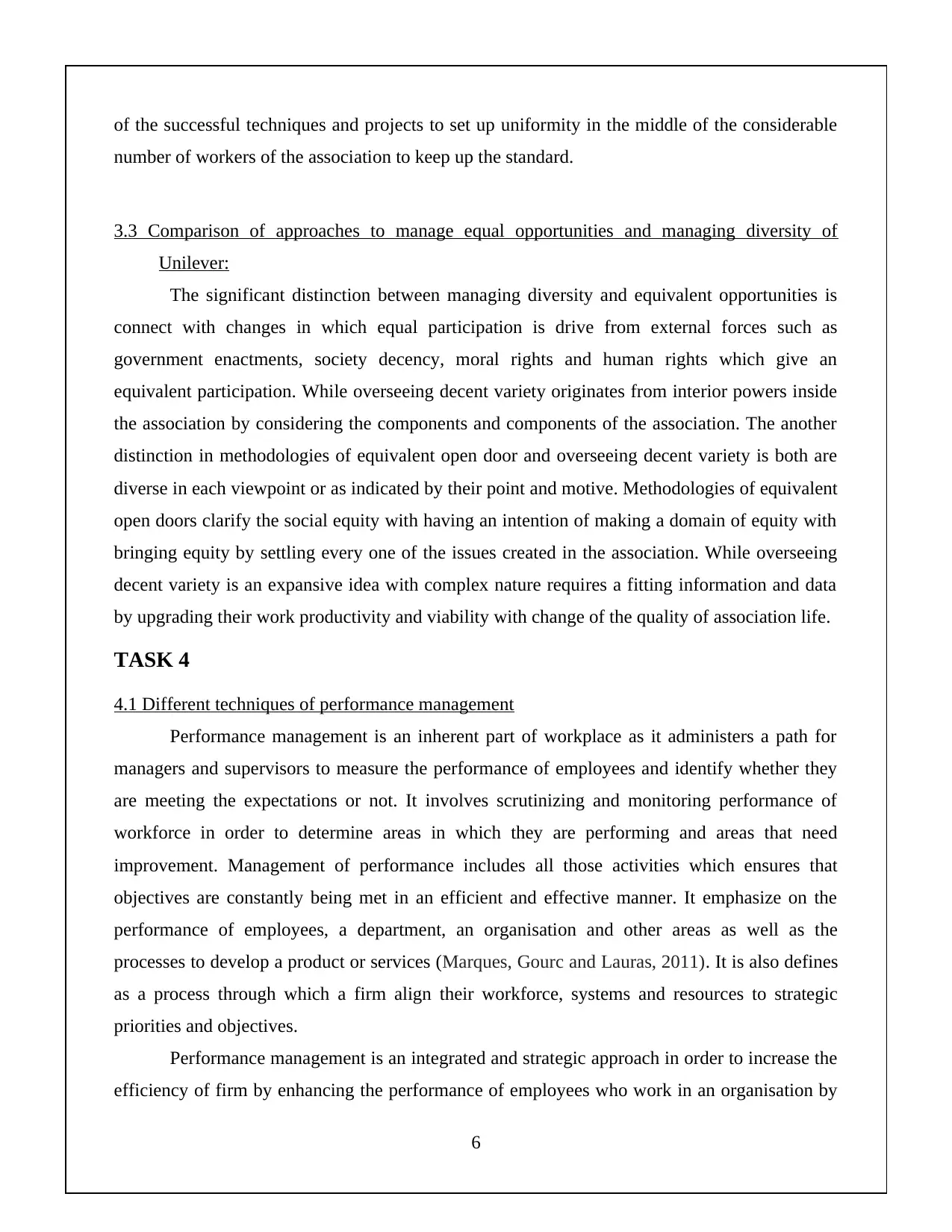
of the successful techniques and projects to set up uniformity in the middle of the considerable
number of workers of the association to keep up the standard.
3.3 Comparison of approaches to manage equal opportunities and managing diversity of
Unilever:
The significant distinction between managing diversity and equivalent opportunities is
connect with changes in which equal participation is drive from external forces such as
government enactments, society decency, moral rights and human rights which give an
equivalent participation. While overseeing decent variety originates from interior powers inside
the association by considering the components and components of the association. The another
distinction in methodologies of equivalent open door and overseeing decent variety is both are
diverse in each viewpoint or as indicated by their point and motive. Methodologies of equivalent
open doors clarify the social equity with having an intention of making a domain of equity with
bringing equity by settling every one of the issues created in the association. While overseeing
decent variety is an expansive idea with complex nature requires a fitting information and data
by upgrading their work productivity and viability with change of the quality of association life.
TASK 4
4.1 Different techniques of performance management
Performance management is an inherent part of workplace as it administers a path for
managers and supervisors to measure the performance of employees and identify whether they
are meeting the expectations or not. It involves scrutinizing and monitoring performance of
workforce in order to determine areas in which they are performing and areas that need
improvement. Management of performance includes all those activities which ensures that
objectives are constantly being met in an efficient and effective manner. It emphasize on the
performance of employees, a department, an organisation and other areas as well as the
processes to develop a product or services (Marques, Gourc and Lauras, 2011). It is also defines
as a process through which a firm align their workforce, systems and resources to strategic
priorities and objectives.
Performance management is an integrated and strategic approach in order to increase the
efficiency of firm by enhancing the performance of employees who work in an organisation by
6
number of workers of the association to keep up the standard.
3.3 Comparison of approaches to manage equal opportunities and managing diversity of
Unilever:
The significant distinction between managing diversity and equivalent opportunities is
connect with changes in which equal participation is drive from external forces such as
government enactments, society decency, moral rights and human rights which give an
equivalent participation. While overseeing decent variety originates from interior powers inside
the association by considering the components and components of the association. The another
distinction in methodologies of equivalent open door and overseeing decent variety is both are
diverse in each viewpoint or as indicated by their point and motive. Methodologies of equivalent
open doors clarify the social equity with having an intention of making a domain of equity with
bringing equity by settling every one of the issues created in the association. While overseeing
decent variety is an expansive idea with complex nature requires a fitting information and data
by upgrading their work productivity and viability with change of the quality of association life.
TASK 4
4.1 Different techniques of performance management
Performance management is an inherent part of workplace as it administers a path for
managers and supervisors to measure the performance of employees and identify whether they
are meeting the expectations or not. It involves scrutinizing and monitoring performance of
workforce in order to determine areas in which they are performing and areas that need
improvement. Management of performance includes all those activities which ensures that
objectives are constantly being met in an efficient and effective manner. It emphasize on the
performance of employees, a department, an organisation and other areas as well as the
processes to develop a product or services (Marques, Gourc and Lauras, 2011). It is also defines
as a process through which a firm align their workforce, systems and resources to strategic
priorities and objectives.
Performance management is an integrated and strategic approach in order to increase the
efficiency of firm by enhancing the performance of employees who work in an organisation by
6
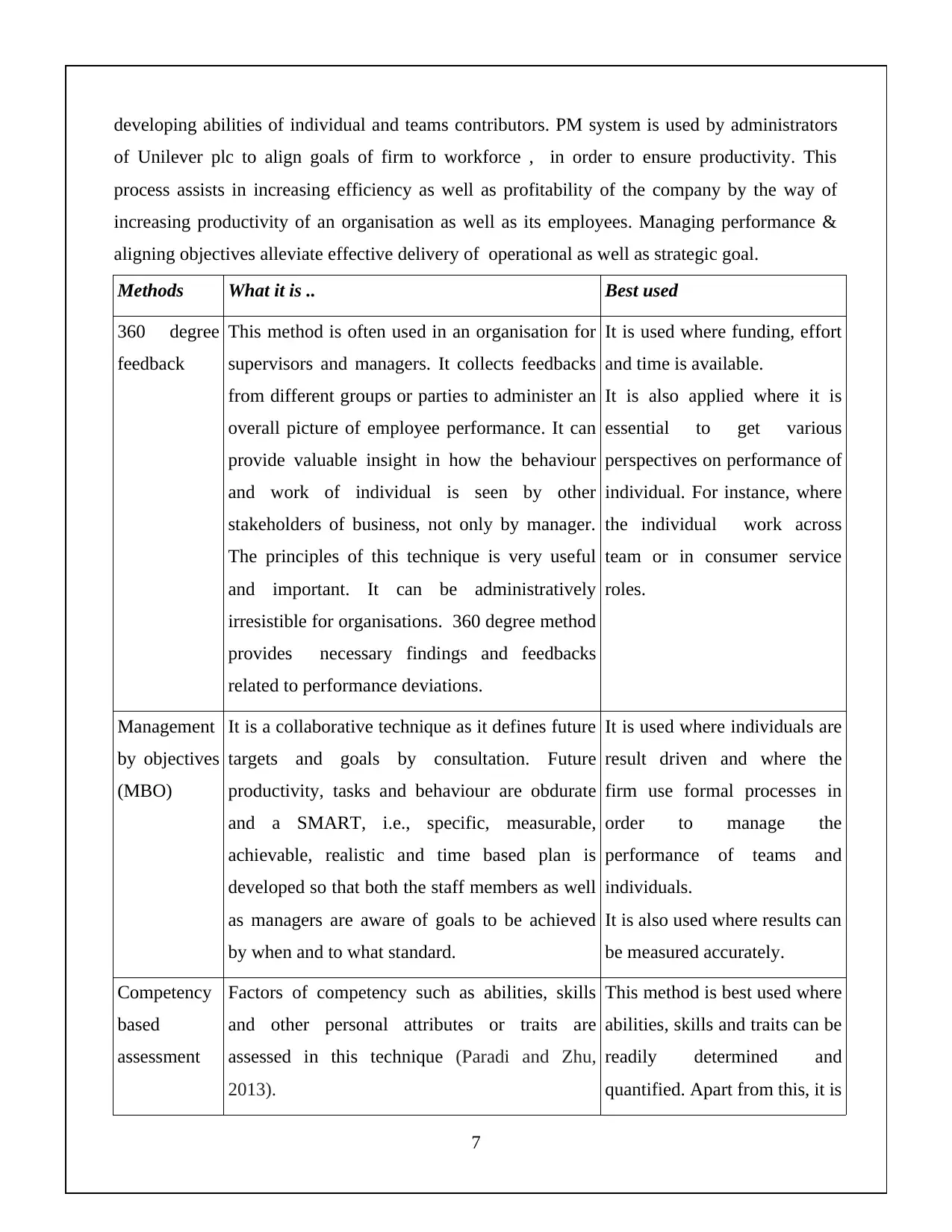
developing abilities of individual and teams contributors. PM system is used by administrators
of Unilever plc to align goals of firm to workforce , in order to ensure productivity. This
process assists in increasing efficiency as well as profitability of the company by the way of
increasing productivity of an organisation as well as its employees. Managing performance &
aligning objectives alleviate effective delivery of operational as well as strategic goal.
Methods What it is .. Best used
360 degree
feedback
This method is often used in an organisation for
supervisors and managers. It collects feedbacks
from different groups or parties to administer an
overall picture of employee performance. It can
provide valuable insight in how the behaviour
and work of individual is seen by other
stakeholders of business, not only by manager.
The principles of this technique is very useful
and important. It can be administratively
irresistible for organisations. 360 degree method
provides necessary findings and feedbacks
related to performance deviations.
It is used where funding, effort
and time is available.
It is also applied where it is
essential to get various
perspectives on performance of
individual. For instance, where
the individual work across
team or in consumer service
roles.
Management
by objectives
(MBO)
It is a collaborative technique as it defines future
targets and goals by consultation. Future
productivity, tasks and behaviour are obdurate
and a SMART, i.e., specific, measurable,
achievable, realistic and time based plan is
developed so that both the staff members as well
as managers are aware of goals to be achieved
by when and to what standard.
It is used where individuals are
result driven and where the
firm use formal processes in
order to manage the
performance of teams and
individuals.
It is also used where results can
be measured accurately.
Competency
based
assessment
Factors of competency such as abilities, skills
and other personal attributes or traits are
assessed in this technique (Paradi and Zhu,
2013).
This method is best used where
abilities, skills and traits can be
readily determined and
quantified. Apart from this, it is
7
of Unilever plc to align goals of firm to workforce , in order to ensure productivity. This
process assists in increasing efficiency as well as profitability of the company by the way of
increasing productivity of an organisation as well as its employees. Managing performance &
aligning objectives alleviate effective delivery of operational as well as strategic goal.
Methods What it is .. Best used
360 degree
feedback
This method is often used in an organisation for
supervisors and managers. It collects feedbacks
from different groups or parties to administer an
overall picture of employee performance. It can
provide valuable insight in how the behaviour
and work of individual is seen by other
stakeholders of business, not only by manager.
The principles of this technique is very useful
and important. It can be administratively
irresistible for organisations. 360 degree method
provides necessary findings and feedbacks
related to performance deviations.
It is used where funding, effort
and time is available.
It is also applied where it is
essential to get various
perspectives on performance of
individual. For instance, where
the individual work across
team or in consumer service
roles.
Management
by objectives
(MBO)
It is a collaborative technique as it defines future
targets and goals by consultation. Future
productivity, tasks and behaviour are obdurate
and a SMART, i.e., specific, measurable,
achievable, realistic and time based plan is
developed so that both the staff members as well
as managers are aware of goals to be achieved
by when and to what standard.
It is used where individuals are
result driven and where the
firm use formal processes in
order to manage the
performance of teams and
individuals.
It is also used where results can
be measured accurately.
Competency
based
assessment
Factors of competency such as abilities, skills
and other personal attributes or traits are
assessed in this technique (Paradi and Zhu,
2013).
This method is best used where
abilities, skills and traits can be
readily determined and
quantified. Apart from this, it is
7
⊘ This is a preview!⊘
Do you want full access?
Subscribe today to unlock all pages.

Trusted by 1+ million students worldwide
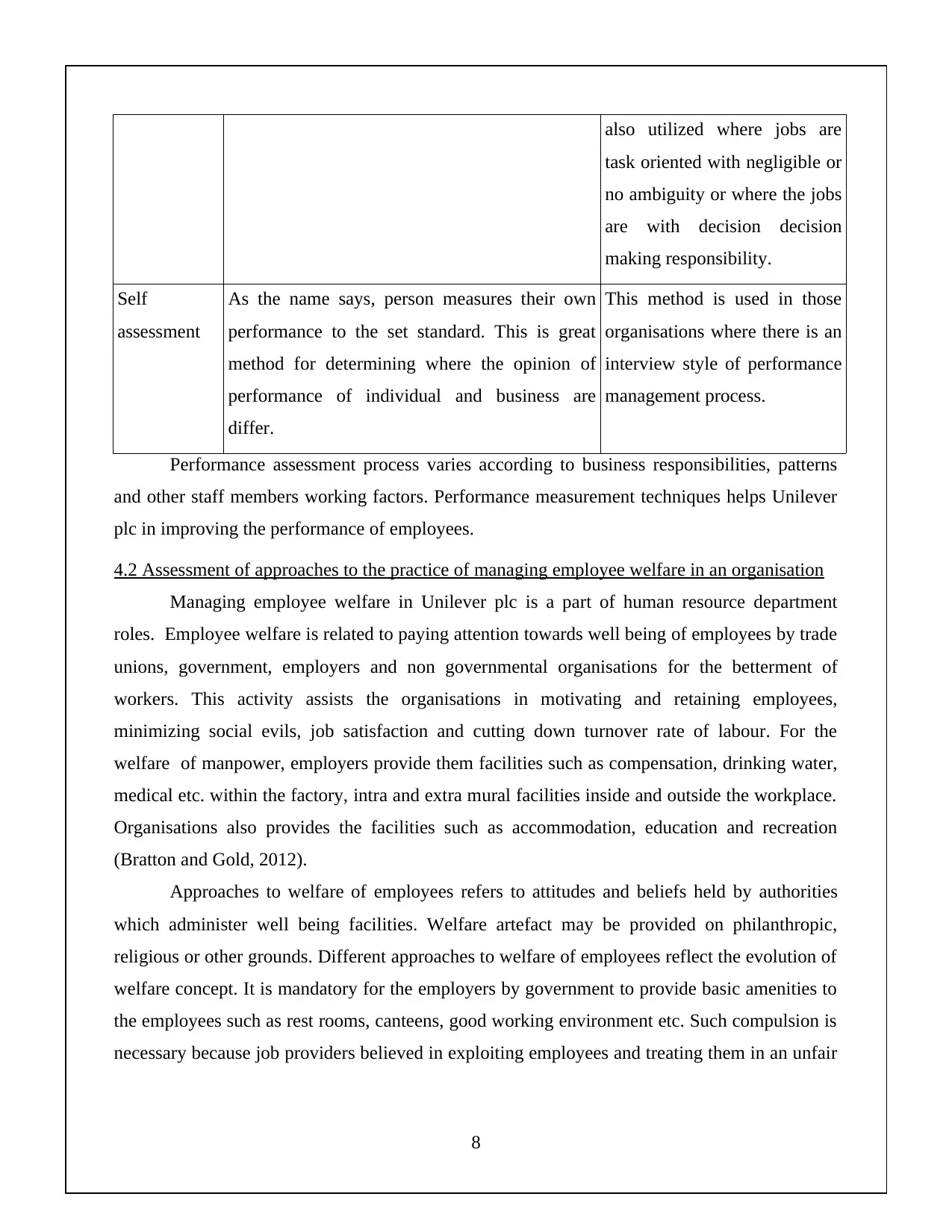
also utilized where jobs are
task oriented with negligible or
no ambiguity or where the jobs
are with decision decision
making responsibility.
Self
assessment
As the name says, person measures their own
performance to the set standard. This is great
method for determining where the opinion of
performance of individual and business are
differ.
This method is used in those
organisations where there is an
interview style of performance
management process.
Performance assessment process varies according to business responsibilities, patterns
and other staff members working factors. Performance measurement techniques helps Unilever
plc in improving the performance of employees.
4.2 Assessment of approaches to the practice of managing employee welfare in an organisation
Managing employee welfare in Unilever plc is a part of human resource department
roles. Employee welfare is related to paying attention towards well being of employees by trade
unions, government, employers and non governmental organisations for the betterment of
workers. This activity assists the organisations in motivating and retaining employees,
minimizing social evils, job satisfaction and cutting down turnover rate of labour. For the
welfare of manpower, employers provide them facilities such as compensation, drinking water,
medical etc. within the factory, intra and extra mural facilities inside and outside the workplace.
Organisations also provides the facilities such as accommodation, education and recreation
(Bratton and Gold, 2012).
Approaches to welfare of employees refers to attitudes and beliefs held by authorities
which administer well being facilities. Welfare artefact may be provided on philanthropic,
religious or other grounds. Different approaches to welfare of employees reflect the evolution of
welfare concept. It is mandatory for the employers by government to provide basic amenities to
the employees such as rest rooms, canteens, good working environment etc. Such compulsion is
necessary because job providers believed in exploiting employees and treating them in an unfair
8
task oriented with negligible or
no ambiguity or where the jobs
are with decision decision
making responsibility.
Self
assessment
As the name says, person measures their own
performance to the set standard. This is great
method for determining where the opinion of
performance of individual and business are
differ.
This method is used in those
organisations where there is an
interview style of performance
management process.
Performance assessment process varies according to business responsibilities, patterns
and other staff members working factors. Performance measurement techniques helps Unilever
plc in improving the performance of employees.
4.2 Assessment of approaches to the practice of managing employee welfare in an organisation
Managing employee welfare in Unilever plc is a part of human resource department
roles. Employee welfare is related to paying attention towards well being of employees by trade
unions, government, employers and non governmental organisations for the betterment of
workers. This activity assists the organisations in motivating and retaining employees,
minimizing social evils, job satisfaction and cutting down turnover rate of labour. For the
welfare of manpower, employers provide them facilities such as compensation, drinking water,
medical etc. within the factory, intra and extra mural facilities inside and outside the workplace.
Organisations also provides the facilities such as accommodation, education and recreation
(Bratton and Gold, 2012).
Approaches to welfare of employees refers to attitudes and beliefs held by authorities
which administer well being facilities. Welfare artefact may be provided on philanthropic,
religious or other grounds. Different approaches to welfare of employees reflect the evolution of
welfare concept. It is mandatory for the employers by government to provide basic amenities to
the employees such as rest rooms, canteens, good working environment etc. Such compulsion is
necessary because job providers believed in exploiting employees and treating them in an unfair
8
Paraphrase This Document
Need a fresh take? Get an instant paraphrase of this document with our AI Paraphraser

way. Many progressive organisations administer well being facilities today, voluntarily & with
enthusiasm and enlightened willingness.
The main aim of providing welfare to employees is to enable the workers to perform
their duties in healthy surroundings conducive to high morale and good health. Companies
maintain benefits and welfare to workers in order to motivate them so that they are able to
perform well. It includes certain approaches and activities that will provide services, security
and facilities to manpower in extra of their salary earning (Pereira and Anderson, 2012).
Labour welfare has following objectives:-
Administer a secured and satisfied working experience.
Improve behaviour, skills and characteristic & emphasize on weakness.
Provide healthy and better work life to the staff members.
Maintain and control a good link with the worker union.
The labour welfare outlines are categorized into two schemes:
A) Statutory welfare scheme
In this scheme, basic amenities are provided to the employees which includes medical
appliances, drinking water, rest room, sitting arrangement, toilet facility, spittoons etc.
B) Non statutory welfare scheme
In this scheme, harassment law, health care, maternity leave, medical insurance service,
co-operation, transfer scheme etc. are administer to the employees for their welfare or well
being.
Approaches to labour welfare:
Philanthropic theory: This theory is related with the affection for mankind. This theory
refers to provision of good working conditions out of commiseration on part of job providers
who want to take out weaknesses of workers. Philanthropic theory is common in social well
being.
Religion theory: It had 2 connotations, i.e., atonement and investment aspects. The
atonement aspect implies that present disabilities of an individual are the outcome of sins sworn
by him or her previously. He or she should initiate to do good deeds today to compensate for
sins. The investment aspect implies that fruits of today's works whether it is good or bad, will
reaped tomorrow. So, these are treated as investment.
9
enthusiasm and enlightened willingness.
The main aim of providing welfare to employees is to enable the workers to perform
their duties in healthy surroundings conducive to high morale and good health. Companies
maintain benefits and welfare to workers in order to motivate them so that they are able to
perform well. It includes certain approaches and activities that will provide services, security
and facilities to manpower in extra of their salary earning (Pereira and Anderson, 2012).
Labour welfare has following objectives:-
Administer a secured and satisfied working experience.
Improve behaviour, skills and characteristic & emphasize on weakness.
Provide healthy and better work life to the staff members.
Maintain and control a good link with the worker union.
The labour welfare outlines are categorized into two schemes:
A) Statutory welfare scheme
In this scheme, basic amenities are provided to the employees which includes medical
appliances, drinking water, rest room, sitting arrangement, toilet facility, spittoons etc.
B) Non statutory welfare scheme
In this scheme, harassment law, health care, maternity leave, medical insurance service,
co-operation, transfer scheme etc. are administer to the employees for their welfare or well
being.
Approaches to labour welfare:
Philanthropic theory: This theory is related with the affection for mankind. This theory
refers to provision of good working conditions out of commiseration on part of job providers
who want to take out weaknesses of workers. Philanthropic theory is common in social well
being.
Religion theory: It had 2 connotations, i.e., atonement and investment aspects. The
atonement aspect implies that present disabilities of an individual are the outcome of sins sworn
by him or her previously. He or she should initiate to do good deeds today to compensate for
sins. The investment aspect implies that fruits of today's works whether it is good or bad, will
reaped tomorrow. So, these are treated as investment.
9
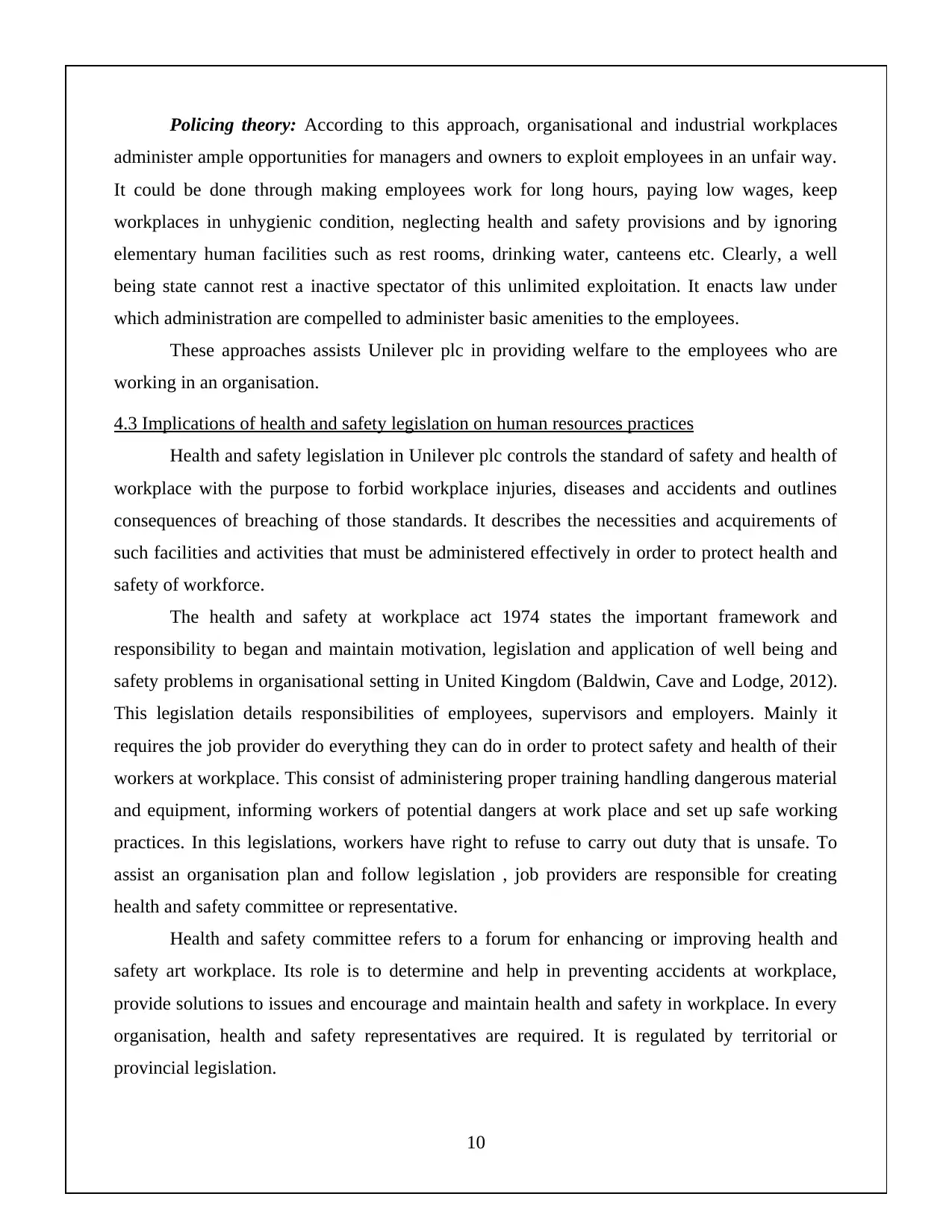
Policing theory: According to this approach, organisational and industrial workplaces
administer ample opportunities for managers and owners to exploit employees in an unfair way.
It could be done through making employees work for long hours, paying low wages, keep
workplaces in unhygienic condition, neglecting health and safety provisions and by ignoring
elementary human facilities such as rest rooms, drinking water, canteens etc. Clearly, a well
being state cannot rest a inactive spectator of this unlimited exploitation. It enacts law under
which administration are compelled to administer basic amenities to the employees.
These approaches assists Unilever plc in providing welfare to the employees who are
working in an organisation.
4.3 Implications of health and safety legislation on human resources practices
Health and safety legislation in Unilever plc controls the standard of safety and health of
workplace with the purpose to forbid workplace injuries, diseases and accidents and outlines
consequences of breaching of those standards. It describes the necessities and acquirements of
such facilities and activities that must be administered effectively in order to protect health and
safety of workforce.
The health and safety at workplace act 1974 states the important framework and
responsibility to began and maintain motivation, legislation and application of well being and
safety problems in organisational setting in United Kingdom (Baldwin, Cave and Lodge, 2012).
This legislation details responsibilities of employees, supervisors and employers. Mainly it
requires the job provider do everything they can do in order to protect safety and health of their
workers at workplace. This consist of administering proper training handling dangerous material
and equipment, informing workers of potential dangers at work place and set up safe working
practices. In this legislations, workers have right to refuse to carry out duty that is unsafe. To
assist an organisation plan and follow legislation , job providers are responsible for creating
health and safety committee or representative.
Health and safety committee refers to a forum for enhancing or improving health and
safety art workplace. Its role is to determine and help in preventing accidents at workplace,
provide solutions to issues and encourage and maintain health and safety in workplace. In every
organisation, health and safety representatives are required. It is regulated by territorial or
provincial legislation.
10
administer ample opportunities for managers and owners to exploit employees in an unfair way.
It could be done through making employees work for long hours, paying low wages, keep
workplaces in unhygienic condition, neglecting health and safety provisions and by ignoring
elementary human facilities such as rest rooms, drinking water, canteens etc. Clearly, a well
being state cannot rest a inactive spectator of this unlimited exploitation. It enacts law under
which administration are compelled to administer basic amenities to the employees.
These approaches assists Unilever plc in providing welfare to the employees who are
working in an organisation.
4.3 Implications of health and safety legislation on human resources practices
Health and safety legislation in Unilever plc controls the standard of safety and health of
workplace with the purpose to forbid workplace injuries, diseases and accidents and outlines
consequences of breaching of those standards. It describes the necessities and acquirements of
such facilities and activities that must be administered effectively in order to protect health and
safety of workforce.
The health and safety at workplace act 1974 states the important framework and
responsibility to began and maintain motivation, legislation and application of well being and
safety problems in organisational setting in United Kingdom (Baldwin, Cave and Lodge, 2012).
This legislation details responsibilities of employees, supervisors and employers. Mainly it
requires the job provider do everything they can do in order to protect safety and health of their
workers at workplace. This consist of administering proper training handling dangerous material
and equipment, informing workers of potential dangers at work place and set up safe working
practices. In this legislations, workers have right to refuse to carry out duty that is unsafe. To
assist an organisation plan and follow legislation , job providers are responsible for creating
health and safety committee or representative.
Health and safety committee refers to a forum for enhancing or improving health and
safety art workplace. Its role is to determine and help in preventing accidents at workplace,
provide solutions to issues and encourage and maintain health and safety in workplace. In every
organisation, health and safety representatives are required. It is regulated by territorial or
provincial legislation.
10
⊘ This is a preview!⊘
Do you want full access?
Subscribe today to unlock all pages.

Trusted by 1+ million students worldwide
1 out of 16
Related Documents
Your All-in-One AI-Powered Toolkit for Academic Success.
+13062052269
info@desklib.com
Available 24*7 on WhatsApp / Email
![[object Object]](/_next/static/media/star-bottom.7253800d.svg)
Unlock your academic potential
Copyright © 2020–2025 A2Z Services. All Rights Reserved. Developed and managed by ZUCOL.





